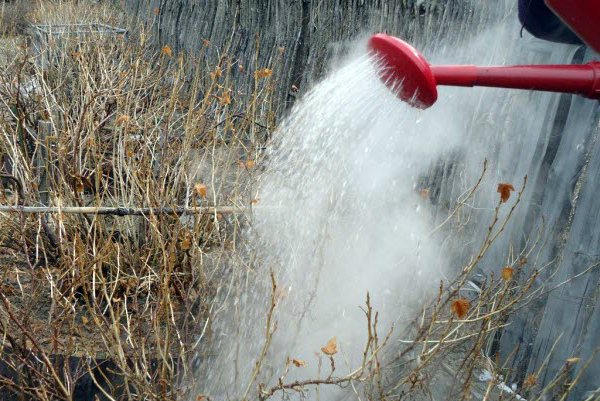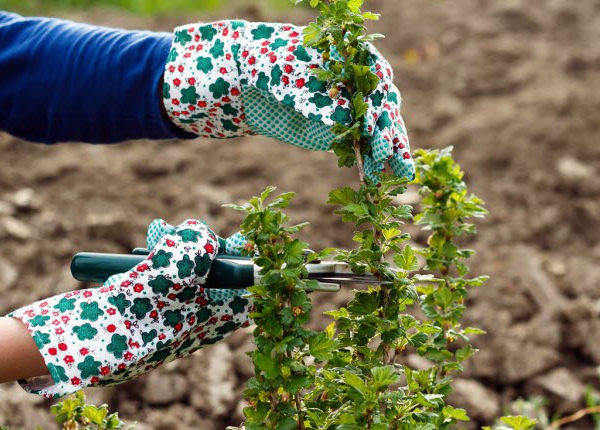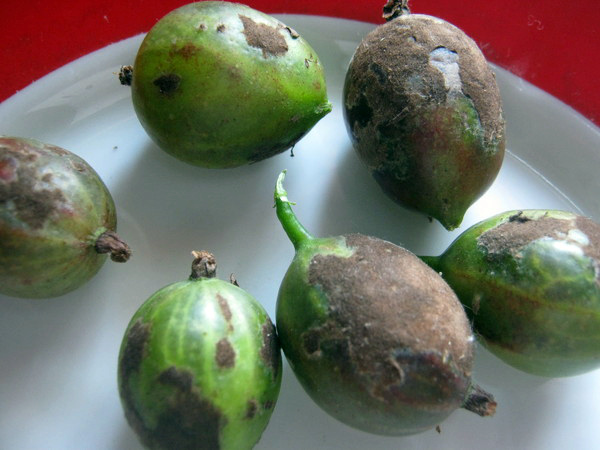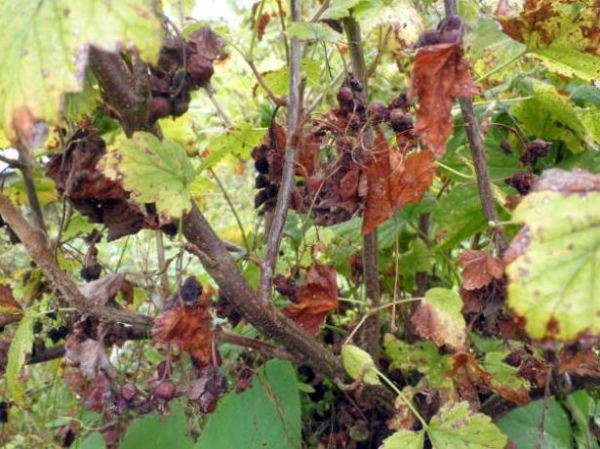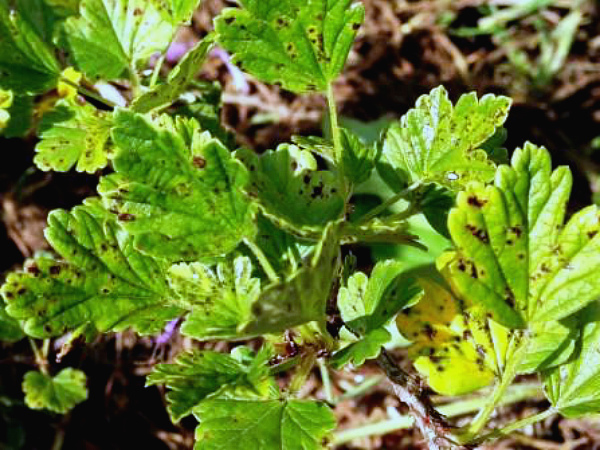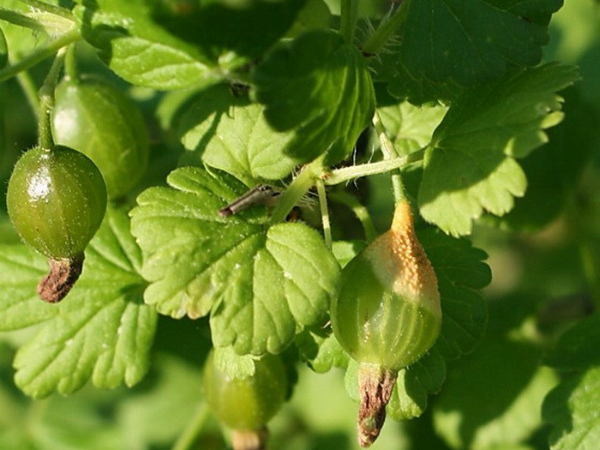Gooseberry diseases: description and methods of struggle
Content
Disease prevention
As you know, the best treatment is disease prevention. This statement works with both the human body and the plants in your garden.
So that gooseberry diseases and colonies of insect pests do not spoil your sunny summer and do not destroy your crops, it is necessary to regularly carry out a set of wellness procedures for the bush.
First of all, it is necessary to treat the bushes with fungicides and insecticides several times a year, since the choice of drugs is now plentiful, you can choose not only an effective, but also an inexpensive remedy, for example, “Ridomil Gold” or “Fitosporin”.
Among folk remedies, the treatment of bushes with boiling water is effective. It is carried out in the spring, in the middle or at the end of March. You will need a bucket of water, heated to 80 ºC, with which you need to spray the bush. For ease of use, pour it into a spray can. One bucket of hot water is usually enough for 4-5 bushes.
It is imperative to collect fallen leaves (including those that do not belong to gooseberries), as well as weed out. It is advisable not to send them to the compost pit, but to burn them in order to surely destroy the fungus, viruses and pest masonry. To avoid breeding butterflies, cover the trunk circle of the bush with roofing material.
In the spring, before the first buds appear, you need to cut off broken branches, darkened and frostbitten shoots. Remove branches affected by fungal diseases throughout the year so as not to put the entire bush and neighboring plants at risk of infection. Also in the spring, but already when the buds are blooming, the gooseberry bushes need to be treated with 3% Bordeaux liquid, and during the season every two weeks - 1% Bordeaux liquid.
Remember that gooseberry diseases often develop actively in the spring, and in the fall they "hibernate" in plant debris, ground, and bushes.
Powdery mildew
One of the most common gooseberry diseases is spheroteka, or American powdery mildew. It differs little from ordinary powdery mildew, but this only plays into the hands of gardeners, because the treatment is also very similar. The first symptoms appear after the end of flowering - the leaves of the gooseberry are covered with a white bloom. Its structure is very loose, it is well erased from leaves, so it is rather difficult to confuse spheroteca spores with bird droppings. Over time, the fungus spreads to the ovaries and formed berries, gradually darkens and becomes denser, acquiring the appearance of a brown crust. At this moment, you can already notice it and start treating the plant. If you do not act, then the affected parts of the bush begin to bend, the leaves curl into a tube, and the berries crack and crumble.
The main danger of the spheroteca is that its spores are easily carried by the wind to other plants. Within a week, you may end up with a completely infested garden.
As a preventive measure, in spring and autumn, pour hot water on the bushes and the trunk circle, then you need to treat the plant with 3% Bordeaux liquid or soda solution with soap.
As a treatment, you can use ash infusion, diluting 300 g of ash in 10 liters of water. A 3-day infusion of mullein has proven itself well, which is diluted 1:10, filtered, and then sprayed with it on infected bushes. Among folk remedies, an infusion of tomato shoots is distinguished. To do this, you will need 45-55 g of tomato stalks (for example, after pinching), 50 g of grated laundry soap and 10 liters of water. The mixture should be infused for 2 days. Then it is filtered and sprayed on the bushes.
Among the chemical preparations for the destruction of fungal pests, Topaz, Fitosporin, Oksikhom have proven themselves well. Read the description and instructions carefully before use.
In the fall, it is imperative to cut off the damaged parts of the bush so as not to contribute to the further development of the disease.
Anthracnose
Anthracnose is another fungal disease that threatens the life of your garden. The disease manifests itself as small shiny brown tubercles on the leaves. Over time, they seem to merge into one large convex spot. With the development of the disease, the affected leaves wither, darken, and then completely die off. Infection begins from the bottom of the bush.
Intensive growth of anthracnose spores begins in rainy periods or with excessive stagnation of moisture and dampness in the gooseberry near-stem circle. The main negative effect on the plant is not only the wilting of the leaves, but also the slowing down of the growth of new shoots, a decrease in the palatability of the fruit, as well as a low yield.
As a preventive measure, you should carefully remove fallen leaves in the fall, and in the spring, treat the bushes with hot water and fungicides. As soon as you notice the characteristic symptoms of anthracnose, pluck and burn the leaves without pity.
Anthracnose treatment is carried out by spraying gooseberry bushes with a solution of copper sulfate, which is made by mixing 40 g of vitriol with 10 liters of water. Every two weeks from the onset of the disease, it is necessary to spray the leaves with 1% Bordeaux liquid, including in the fall after harvest.
White spot or septoria
Septoria, or gooseberry white spot, appears as many round gray spots on the leaves. Over time, black dots appear on the spots, and the leaves themselves begin to curl into a tube and dry out. Black dots are myceliums, in which new spores are ripening.
Methods for dealing with septoria are similar to those for anthracnose. In spring and autumn, it is imperative to remove all leaves and weeds from the ground, cut off damaged shoots. You also need to loosen and process the trunk circle of the bush with a solution of copper sulfate.
As a prophylaxis for septoria, it is recommended to fertilize gooseberries with manganese sulfate, copper, boron and zinc.
Goblet rust
Goblet rust also adds to the list of pests. It manifests itself on all parts of the bush with yellow spots and growths or orange pads. These neoplasms contain spores of pest fungi. With the course of the disease, they take the form of a glass, which is why the disease got its name.
Goblet rust is active at the beginning of summer, when warm weather sets in. Prior to that, in autumn, winter and spring, she calmly dorms on weeds and gooseberry bushes. If you do not deal with goblet rust, the plant deforms, becomes one-sided, vegetative processes in it slow down. Ultimately, this leads to the fact that the leaves and fruits fall off.
To combat goblet rust, it is recommended to plant varieties that are resistant to it, and also not to plant gooseberries next to sedge. Spores love high humidity, so avoid stagnant water in the bush's trunk circle.
Infected plants should be sprayed with 1% Bordeaux liquid every 10-12 days. You can also use the drug "Fitosporin".
Gooseberry mosaic
One of the most insidious gooseberry diseases is mosaic.Unlike previous pests, this is a viral disease that develops in living cells of plants and insects. The main vectors are aphids and ticks.
On the leaves of the gooseberry, yellow spots appear next to the veins. Gradually, the spots increase in size, slowing down the vegetative processes of the bush. Deformation of leaves and shoots, a decrease in yield are noted.
As a fight against gooseberry mosaic, you have to go to extreme measures - remove infected plants and burn them.
But as a preventive measure, only healthy seedlings should be planted, thoroughly sprayed with anti-insect preparations, and garden tools should be disinfected. In the spring, it is imperative to carry out complex spraying with insecticides and disinfect the soil.
Video "The biggest danger to gooseberries"
This video is about a disease that is considered the "Achilles heel" of gooseberry planting. We are talking about American powdery mildew, as well as ways to defeat it at their summer cottage.

